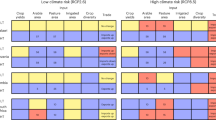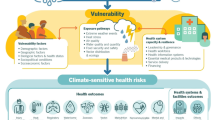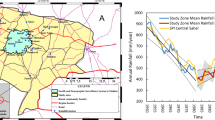Abstract
Climate-smart agriculture (CSA) is an approach for transforming and reorienting agricultural systems to support food security under the new realities of climate change. Widespread changes in rainfall and temperature patterns threaten agricultural production and increase the vulnerability of people dependent on agriculture for their livelihoods, which includes most of the world's poor. Climate change disrupts food markets, posing population-wide risks to food supply. Threats can be reduced by increasing the adaptive capacity of farmers as well as increasing resilience and resource use efficiency in agricultural production systems. CSA promotes coordinated actions by farmers, researchers, private sector, civil society and policymakers towards climate-resilient pathways through four main action areas: (1) building evidence; (2) increasing local institutional effectiveness; (3) fostering coherence between climate and agricultural policies; and (4) linking climate and agricultural financing. CSA differs from 'business-as-usual' approaches by emphasizing the capacity to implement flexible, context-specific solutions, supported by innovative policy and financing actions.
This is a preview of subscription content, access via your institution
Access options
Subscribe to this journal
Receive 12 print issues and online access
$209.00 per year
only $17.42 per issue
Buy this article
- Purchase on Springer Link
- Instant access to full article PDF
Prices may be subject to local taxes which are calculated during checkout

Similar content being viewed by others
Change history
13 March 2015
In the version of this Perspective originally published, the list of authors and affiliations should have read as below. These errors have been corrected in the online versions of the Perspective. Leslie Lipper1*, Philip Thornton2,3, Bruce M. Campbell3,4, Tobias Baedeker5, Ademola Braimoh5, Martin Bwalya6, Patrick Caron7, Andrea Cattaneo1, Dennis Garrity8, Kevin Henry9, Ryan Hottle10, Louise Jackson11, Andrew Jarvis3,4, Fred Kossam12, Wendy Mann1, Nancy McCarthy13, Alexandre Meybeck1, Henry Neufeldt8, Tom Remington14, Pham Thi Sen15, Reuben Sessa1, Reynolds Shula16, Austin Tibu17 and Emmanuel F. Torquebiau7 1Food and Agriculture Organization of the United Nations (FAO), Viale delle Terme di Caracalla, 00153 Rome, Italy. 2International Livestock Research Institute (ILRI), PO Box 30709, Nairobi 00100, Kenya. 3Consultative Group on International Agricultural Research (CGIAR) Research Program on Climate Change, Agriculture, and Food Security (CCAFS), University of Copenhagen, Faculty of Science, Department of Plant and Environmental Sciences, Rolighedsvej 21, DK-1958, Frederiksberg C, Copenhagen, Denmark. 4International Center for Tropical Agriculture (CIAT), Km 17, Recta Cali-Palmira, Apartado Aéreo 6713, Cali, Colombia. 5World Bank, Agriculture Global Practice, 1818 H Street NW, Washington DC 20433, USA. 6New Partnership for Africa's Development (NEPAD), International Business Gateway New Road and 6th Road, Midridge Office Park c/o Challenger and Columbia Avenue, Block B Midrand Johannesburg 1685, South Africa. 7French Agricultural Research Centre for International Development (CIRAD), TA 179/04, Avenue Agropolis, 34398 Montpellier Cedex 5, France. 8World Agroforestry Centre (ICRAF), United Nations Avenue, Gigiri, PO Box 30677-00100 Nairobi, Kenya. 9Colorado State University, School of Global Environmental Sustainability, 108 Johnson Hall, Fort Collins, Colorado 80523, USA. 10Ohio State University (OSU) International Programs in Agriculture and School of Environment and Natural Resources Office of International Programs in Agriculture, 113 Agricultural Administration Building, The Ohio State University, 2120 Fyffe Road, Columbus, Ohio 43210, USA. 11University of California, Davis, Department of Land, Air and Water Resources, 3144 PES Building, University of California, One Shields Avenue, Davis, California 95616, USA. 12Ministry of Environment and Climate Change Management, Malawi, Department of Climate Change and Met Services, PO Box 1808 Blantyre, Malawi. 13Law, Economics and Agriculture for Development (LEAD) Analytics, 5136 Nebraska Avenue NW, Washington DC, USA. 14International Potato Center (CIP), PO Box 31600, Lilongwe 3, Malawi. 15Northern Mountainous Agriculture and Forestry Science Institute, Viet Nam (NOMAFSI), Phu Ho Commun, Phu Tho District, Phu Tho Province, Viet Nam. 16Ministry of Agriculture and Livestock, Zambia, Department of Agriculture, Mulungushi House, PO Box 50291, Lusaka, Zambia. 17Ministry of Agriculture and Food Security, Malawi, Land Resources Conservation Department, PO Box 30291, Lilongwe, Malawi. *e-mail: leslie.lipper@fao.org
References
Wheeler, T. & von Braun, J. Climate change impacts on global food security. Science 341, 508–513 (2013). This paper shows that it is likely that climate variability and change will exacerbate food insecurity in areas currently vulnerable to hunger and undernutrition, indicating the need for considerable investment in adaptation and mitigation to build climate smart agricultural systems.
Rural Poverty Report 2011 (International Fund for Agricultural Development, 2011).
Alexandratos, N. & Bruinsma, J. World Agriculture Towards 2030/2050: The 2012 Revision ESA Working paper No. 12–03 (FAO, 2012).
IPCC Summary for Policymakers Climate Change 2014: Impacts, Adaptation, and Vulnerability. Part A: Global and Sectoral Aspects (eds Field, C. B. et al.) (Cambridge Univ. Press, 2014).
Porter, J. R. et al. in Climate Change 2014: Impacts, Adaptation, and Vulnerability. Part A: Global and Sectoral Aspects (eds Field, C. B. et al.) 485–533 (IPCC, Cambridge Univ. Press, 2014).
Lobell, D. B., Schlenker, W. & Costa-Roberts, J. Climate trends and global crop production since 1980. Science 333, 616–620 (2011). Models that link yields of the four largest commodity crops to weather indicate that global maize and wheat production declined by 3.8 and 5.5%, respectively, relative to a counterfactual without climate trends.
Battisti, D. S. & Naylor, R. L. Historical warnings of future food insecurity with unprecedented seasonal heat. Science 323, 240–244 (2009).
Wheeler, T. et al. Temperature variability and the yield of annual crops. Agr. Ecosyst. Environ. 82, 159–167 (2000).
Thornton, P. K. & Gerber, P. Livestock production: recent trends, future prospects. Mitig. Adapt. Strateg. Global Change 15, 169–184 (2010). Population growth and dietary change are likely to lead to increased demand for livestock products, but this will be modified by increasing environmental and socioeconomic constraints, and the potential impact of growth in the sector on poverty reduction is uncertain, partly owing to climate change effects.
Olsson, L. et al. in Climate Change 2014: Impacts, Adaptation, and Vulnerability. Part A: Global and Sectoral Aspects (eds Field, C. B. et al.) 793–832 (IPCC, Cambridge Univ. Press, 2014).
Hurley, T. A Review of Agricultural Production Risk in the Developing World Harvest Choice Working Paper 11 (International Food Policy Research Institute, 2010).
Dercon, S. & Christiaensen, L. Consumption risk, technology adoption and poverty traps: evidence from Ethiopia. J. Dev. Econ. 96, 159–173 (2011).
Tubiello, F. N. et al. The FAOSTAT database of greenhouse gas emissions from agriculture. Environ. Res. Lett. 8, 015009 (2013).
Smith, P. et al. in Climate Change 2014: Mitigation of Climate Change Ch. 11 (IPCC, Cambridge Univ. Press, 2014).
IPCC Climate Change 2014: Mitigation of Climate Change (eds Edenhofer, O. et al.) 29, note 4 (Cambridge Univ. Press, 2014)
Climate-Smart Agriculture Sourcebook Executive Summary (Food and Agriculture Organization of the United Nations, 2013)
Garnett, T. et al. Sustainable intensification in agriculture: premises and policy. Science 341, 33–34 (2013). Sustainable intensification is about optimizing productivity and a range of environmental and social outcomes entailing increasing food production from existing farmland in ways that have lower environmental impact and do not undermine our capacity to continue producing food in the future.
International Assessment of Agricultural Knowledge, Science and Technology for Development Agriculture at a Crossroads: Synthesis Report (Island Press, 2009).
Parfitt, J., Barthel, M. & Macnaughton, S. Food waste within food supply chains: quantification and potential for change to 2050. Phil. Trans. Roy. Soc. B 365, 3065–3081 (2010).
Gitz, V. & Meybeck, A. Risks, Vulnerabilities and Resilience in a Context of Climate Change (FAO, 2012).
Thornton, P. K., Ericksen, P. J., Herrero, M. & Challinor, A. J. Climate variability and vulnerability to climate change: a review. Global Change Biol. http://dx.doi.org/10.1111/gcb.12581 (2014).
IPCC Managing the Risks of Extreme Events and Disasters to Advance Climate Change Adaptation (eds Field, C. B. et al.) (Cambridge Univ. Press, 2012).
Vermeulen, S. J., Campbell, B. M. & Ingram, J. S. I. Climate change and food systems. Annu. Rev. Env. Resour. 37, 195–222 (2012). Food systems contribute 19–29% of global anthropogenic greenhouse gas emissions and are also likely to be profoundly affected by climate change, indicating the need for approaches that integrate adaptation and mitigation concerns in agriculture such as sustainable intensification and waste management.
Challinor, A., Martre, P., Asseng, S., Thornton, P. & Ewert, F. Making the most of climate impact ensembles. Nature Clim. Change 4, 77–80 (2014).
Sayer, J. et al. Ten principles for a landscape approach to reconciling agriculture, conservation, and other competing land uses. Proc. Natl Acad. Sci. USA 110, 8349–8356 (2013).
Herrero, M. et al. Exploring future changes in smallholder farming systems by linking socio-economic scenarios with regional and household models. Global Environ. Change 24, 165–182 (2014).
Vervoort, J. M. et al. Challenges to scenario-guided adaptive action on food security under climate change. Global Environ. Change http://dx.doi.org/10.1016/j.gloenvcha.2014.03.001 (2014).
Arslan, A., McCarthy, N., Lipper, L., Asfaw, S. & Cattaneo, A. Adoption and intensity of adoption of conservation farming practices in Zambia. Agr. Ecosyst. Environ. 187, 72–86 (2013).
McCarthy, N., Lipper, L. & Branca, G. Climate-Smart Agriculture: Smallholder Adoption and Implications for Climate Change Adaptation and Mitigation (Mitigation of Climate Change in Agriculture Series No. 4, FAO, 2011).
Institutional Economics Perspectives on African Agricultural Development (International Food Policy Research Institute, 2009).
Antón, J., Cattaneo, A., Kimura, S. & Lankoski, J. Agricultural risk management policies under climate uncertainty. Global Environ. Change 23, 1726–1736 (2013).
World Development Report: Risk and Opportunity: Managing Risk for Development (World Bank, 2014).
Duflo, E., Kremer, M. & Robinson, J. Nudging farmers to use fertilizer: Theory and experimental evidence from Kenya. Am. Econ. Rev. 101, 6, 2350–2390 (2011).
Issues Related to Agriculture: Draft Conclusions Proposed by the Chair (UNFCCC Subsidiary Body for Scientific and Technology Advice, 2014).
State of Food and Agriculture: Investing in Agriculture for a Better Future (FAO, 2012).
Financing Climate-smart Agriculture 375–406 (Climate-Smart Agriculture Sourcebook Module 14, FAO, 2013).
Report on the Sixth Replenishment of the GEF Trust Fund (Global Environment Facility Secretariat (GEF) Secretariat and World Bank, for Fifth GEF Assembly, 2014).
Vermeulen, S. J. et al. Addressing uncertainty in adaptation planning for agriculture. Proc. Natl Acad. Sci. USA 110, 8357–8362 (2013).
Acknowledgements
The views expressed in this article are those of the authors and do not necessarily reflect the views or policies of FAO.
Author information
Authors and Affiliations
Corresponding author
Ethics declarations
Competing interests
The authors declare no competing financial interests.
Rights and permissions
About this article
Cite this article
Lipper, L., Thornton, P., Campbell, B. et al. Climate-smart agriculture for food security. Nature Clim Change 4, 1068–1072 (2014). https://doi.org/10.1038/nclimate2437
Received:
Accepted:
Published:
Issue Date:
DOI: https://doi.org/10.1038/nclimate2437
This article is cited by
-
Futures participation as anticipatory practice — what do futures workshops do?
European Journal of Futures Research (2024)
-
Challenges of optimal crop management
Nature Food (2024)
-
Behavioural factors matter for the adoption of climate-smart agriculture
Scientific Reports (2024)
-
Distributional impact of climate-smart villages on access to savings and credit and adoption of improved climate-smart agricultural practices in the Nyando Basin, Kenya
Mitigation and Adaptation Strategies for Global Change (2024)
-
Plants and global warming: challenges and strategies for a warming world
Plant Cell Reports (2024)



